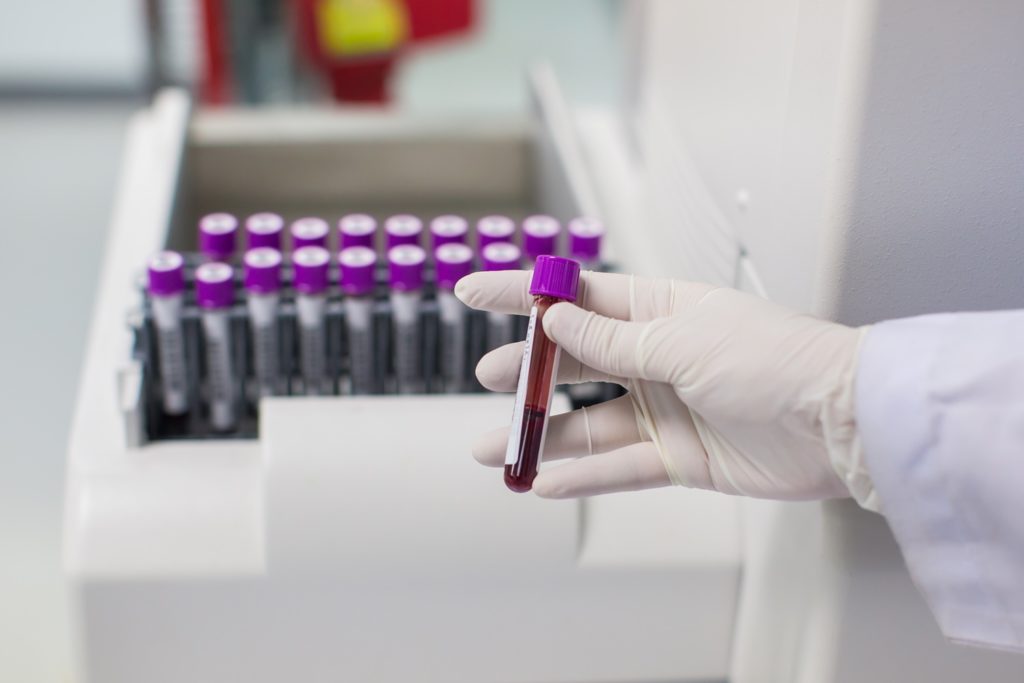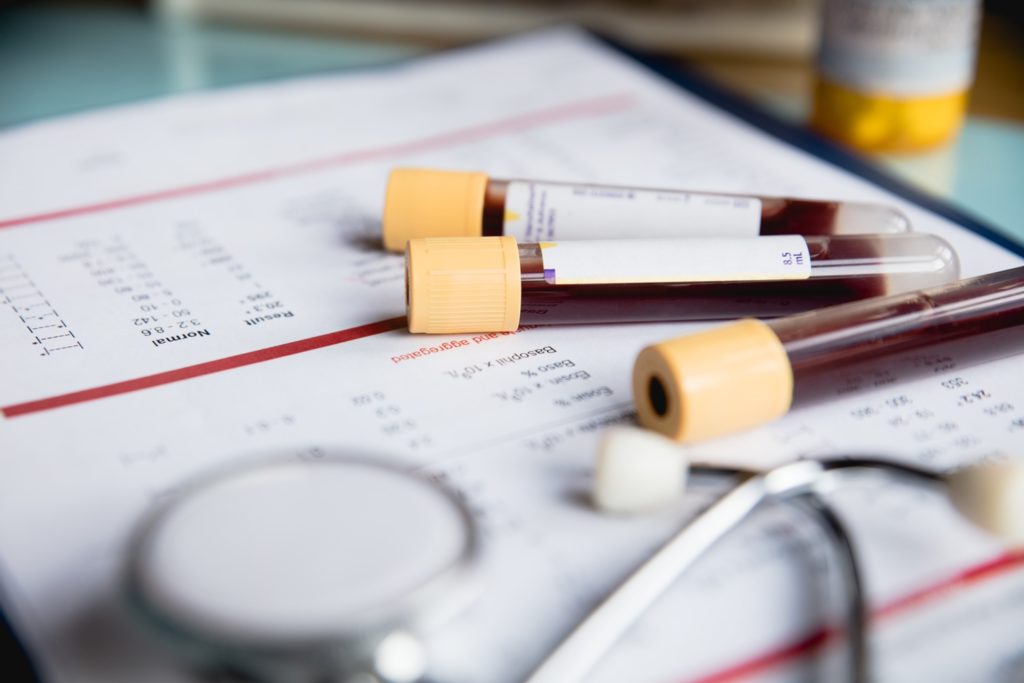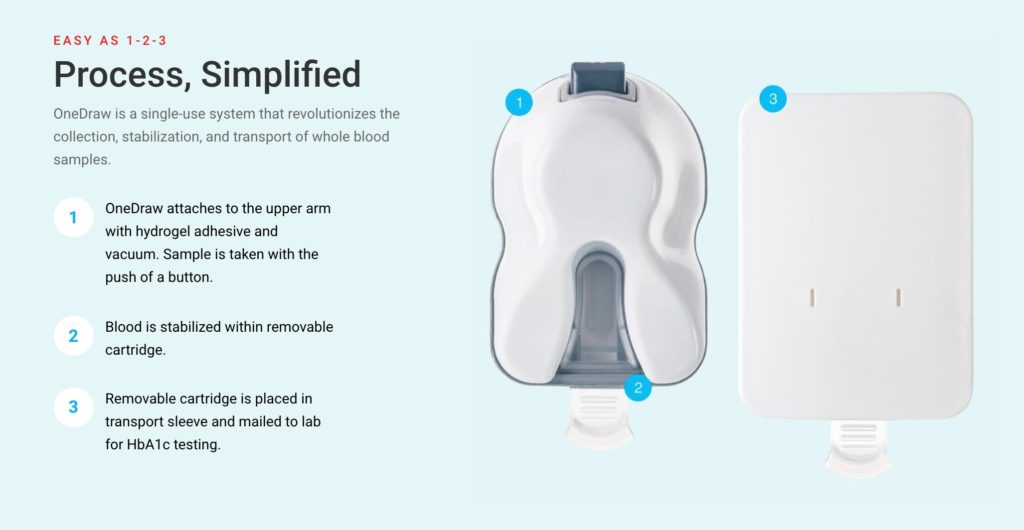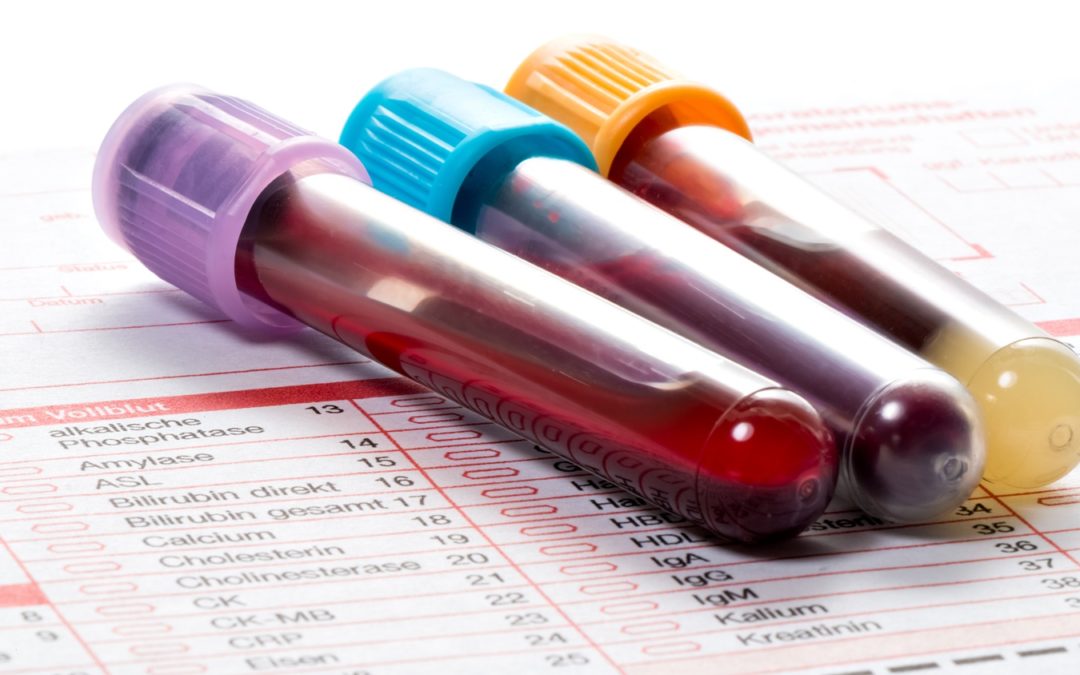Today there are many types of blood tests that inform physicians and researchers about a wide range of health conditions. While some blood tests are specific to uncommon or rare diseases, many tests are crucial for understanding a person’s basic health. Accordingly, everyone should make blood work a regular part of their long-term health regimen.
Here we will review several common types of blood tests, as well as provide information on a new way to collect blood samples: the OneDraw™ Blood Collection Device, the enabling technology for the FDA cleared OneDraw™ A1C Test System by Drawbridge Health.
What is a blood test?
A blood test is any evaluation where a person’s blood is analyzed (“screened”) by a laboratory to gather specific health information.
Blood tests are typically used to assess general health, identify specific infections, measure the performance of a body part or prescribed medicine, or screen for genetic conditions.[1][2]
How are blood tests taken?
The traditional method for collecting blood for testing is called venipuncture, wherein a phlebotomist (a person trained to collect blood) draws venous blood using a needle. Blood is typically drawn from the inner arm (near the elbow) or back of the hand. To make veins visible and prevent infection, a tourniquet is applied to the arm and the needle insertion site is cleaned prior to venipuncture.[3] Patients may experience pain when the needle is inserted, as well as a slight throbbing pain at the site for several hours after the venipuncture procedure.

An alternative method for collecting blood is the “finger-stick” or “finger-prick” method, wherein a small capillary blood sample (i.e., a drop or two) is collected by piercing a patient’s fingertip with a small lancet. If taken at the point of care, the sample is then applied to a test strip, which reacts chemically to provide information.[4] The finger-prick method can be used for collection of dried blood spot samples and capillary blood tube collection for laboratory testing. Typically, tests that utilize small blood sample volumes, such as blood sugar testing, rely on finger-sticks.[5]
What are some common blood tests and what do the results mean?
Several blood tests are used frequently to help physicians fully understand their patient’s health. Patients that receive a blood test are often given the results, which are presented in terms of normative ranges. To put it simply, results are considered normal if they are within the normative range. Some common blood tests include:
HbA1c
The HbA1c (A1C) test measures glycated hemoglobin levels (HbA1c) in a patient’s blood. High levels of HbA1c are associated with impaired glucose regulation and are a hallmark symptom of diabetes and pre-diabetes. Typically screened using finger-stick testing, HbA1c tests help physicians investigate for and diagnose diabetes, as well as help patients self-monitor to keep blood sugar controlled.[6]
| Substance | Range | Meaning |
|---|---|---|
| ≤ 5.7% | Normal | |
| A1C | 5.8-6.4% | Prediabetes |
| ≥ 6.5% (if registered via two separate tests) | Diabetes |
Glucose Testing
Glucose testing measures glucose (sugar) levels in a patient’s blood. Too little or too much glucose (hypo- and hyperglycemia, respectively) can cause multiple acute medical conditions, including (but not limited to) fatigue, blurred vision, and frequent urination (if levels are too high), as well as hunger, trembling, and anxiety (if levels are too low). Blood sugar dysregulation is both a symptom and predictor of the chronic condition diabetes, which can cause severe medical issues such as blindness, kidney failure, and heart disease.[7]
Glucose Blood Tests:
- Random blood sugar test. A blood sample will be taken at a random time. Regardless of when you last ate, a random blood sugar level of 200 milligrams per deciliter (mg/dL) — 11.1 millimoles per liter (mmol/L) — or higher suggests diabetes.[8][9]
- Fasting blood sugar test. A blood sample will be taken after an overnight fast. A fasting blood sugar level less than 100 mg/dL (5.6 mmol/L) is normal. A fasting blood sugar level from 100 to 125 mg/dL (5.6 to 6.9 mmol/L) is considered prediabetes. If it’s 126 mg/dL (7 mmol/L) or higher on two separate tests, you have diabetes.[8][9]
- Oral glucose tolerance test. For this test, you fast overnight, and the fasting blood sugar level is measured. Then you drink a sugary liquid, and blood sugar levels are tested periodically for the next two hours. A blood sugar level less than 140 mg/dL (7.8 mmol/L) is normal. A reading of more than 200 mg/dL (11.1 mmol/L) after two hours indicates diabetes. A reading between 140 and 199 mg/dL (7.8 mmol/L and 11.0 mmol/L) indicates prediabetes.[8][9]
Liver Panel
A liver panel test (sometimes called a hepatic test) is a blood test that assesses liver functionality. The test measures levels of protein, albumin, bilirubin, and liver enzymes. These proteins and enzymes allow the liver to serve its primary function of breaking down nutrients and breaking down toxic, harmful substances.

Doctors typically order a liver panel when a patient displays signs of liver disease, including yellowing of the skin (a byproduct of excess bilirubin), dark yellow urine, and lethargy.[10][11]
Comprehensive Metabolic Panel (CMP)
A comprehensive metabolic panel (CMP) is a group of 14 tests that measure levels of several important substances, including glucose, albumin, calcium, minerals and electrolytes, multiple proteins, and more. CMPs typically include measurements taken by other panels included here, such as glucose panels, lipid panels, and liver panels.[12]
Normative Ranges
The table below contains normative ranges for the 14 blood tests included in the Comprehensive Metabolic Panel.[13] The liver panel measures protein, albumin, bilirubin, and liver enzymes, which are also included in the Comprehensive Metabolic Panel. Normative ranges do change, so it is always best to review test results with your physician.
| Substance | Normal Range |
|---|---|
| Albumin | 3.4 to 5.4 g/dL (34 to 54 g/L) |
| ALP | 20 to 130 U/L |
| ALT | 4 to 36 U/L |
| AST | 8 to 33 U/L |
| BUN | 6 to 20 mg/dL (2.14 to 7.14 mmol/L) |
| Calcium | 8.5 to 10.2 mg/dL (2.13 to 2.55 mmol/L) |
| Chloride | 96 to 106 mEq/L (96 to 106 mmol/L) |
| CO2 (Bicarbonate) | 23 to 29 mEq/L (23 to 29 mmol/L) |
| Creatinine | 0.6 to 1.3 mg/dL (53 to 114.9 µmol/L) |
| Glucose | 70 to 100 mg/dL (3.9 to 5.6 mmol/L) |
| Potassium | 3.7 to 5.2 mEq/L (3.70 to 5.20 mmol/L) |
| Sodium | 135 to 145 mEq/L (135 to 145 mmol/L) |
| Total Bilirubin | 0.1 to 1.2 mg/dL (2 to 21 µmol/L) |
| Total Protein | 6.0 to 8.3 g/dL (60 to 83 g/L) |
OneDraw – A New Way to Collect Blood
The OneDraw Blood Collection Device, developed by Drawbridge Health, streamlines the blood draw process and helps to minimize obstacles to getting blood drawn – like pain, discomfort, multiple visits and wait times.
In clinical studies conducted by Drawbridge Health, participants rated the OneDraw Blood Collection Device to be less painful compared with finger-prick blood collection and 80% preferred using the device compared with finger-prick (12%) and venipuncture (8%) respectively.

The OneDraw A1C Test System, which consists of the OneDraw Blood Collection Device and the OneDraw A1C Test, is intended to collect capillary blood from the upper arm of individuals 18 years of age or older onto filter (matrix) paper within the collection device by a healthcare professional. Samples are delivered to the laboratory for the quantitative measurement of HbA1c for monitoring the long-term control of blood sugar (glucose) in people with diabetes. Testing performed on samples collected with this device should not be used to diagnose or screen for diabetes.
The OneDraw Blood Collection Device enables blood to be drawn quickly, comfortably, and conveniently by a health care professional (HCP). Blood samples are immediately stabilized for shipping and laboratory analysis making the entire experience fast and efficient.
With OneDraw, Drawbridge Health is dedicated to making blood sampling more accessible, convenient, and comfortable creating a positive experience for patients and HCPs.
References:
1. “Overview: Blood Tests,” https://www.nhs.uk/conditions/blood-tests/
2. “Blood Tests,” https://www.nhlbi.nih.gov/health-topics/blood-tests
3. “Venipuncture,” https://medlineplus.gov/ency/article/003423.htm
4. “Fingerstick Procedure For Accurate Glucose Results,” https://www.oregon.gov/DHS/PROVIDERS-PARTNERS/LICENSING/SafeMedDocs/Fingerstick_Training.pdf
5. “Capillary Blood Sampling Protocol,” https://www.cdc.gov/nceh/lead/publications/1997/pdf/c2.pdf
6. “HbA1c Test for Diabetes,” https://www.diabetes.co.uk/hba1c-test.html
7. “Blood Glucose Test,” https://medlineplus.gov/lab-tests/blood-glucose-test/
8. “Diabetes,” https://www.mayoclinic.org/diseases-conditions/diabetes/diagnosis-treatment/drc-20371451
9. “A1C Test,” https://www.mayoclinic.org/tests-procedures/a1c-test/about/pac-20384643
10. “Liver Function Panel,” https://www.uofmhealth.org/health-library/tr61488
11. “Liver Function Tests,” https://www.mayoclinic.org/tests-procedures/liver-function-tests/about/pac-20394595
12. “Comprehensive Metabolic Panel (CMP),” https://labtestsonline.org/tests/comprehensive-metabolic-panel-cmp
13. “Comprehensive metabolic panel,” https://medlineplus.gov/ency/article/003468.htm

